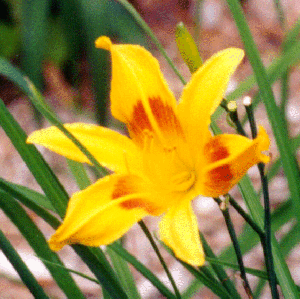
Introduced: 1929 |

|
One year after the first description, A.B. Stout described it as:
" The Mikado Daylily is a seedling recently obtained at The New York Botanical Garden in an effort of selective breeding for the development of fulvous daylilies of special merit as garden plants. It is a complex hybrid having in its parentage the two fulvous daylilies H. aurantiaca and the H. fulva clon Europa, the species H. flava and either H. aurantiaca or "H. aurantiaca major". As may be expected from such a complex ancestry the seedlings thus obtained show much diversity, and the colors of their flowers range from pale lemon yellow through many shades of yellow, of orange, and of fulvous red, both in single color effects and in various combinations of eyed patterns. In the flower of the seedling which was named Mikado the zone of color is more intense and in greater contrast than in any other daylily now known. There is also good size, form, and fullness of flower, and an excellent semi-robust habit of growth. All who have seen this daylily in bloom readily agree that it is a plant of unusual charm and of distinctive merit as a plant for flower gardens. The descriptions of new daylilies published in "House and Garden" for January, 1929, contain the first printed reference to this clon.
The foliage of the Mikado Daylily is medium coarse, ascending curving and reaching a general level of about 20 to 24 inches. The flower stems rise about ten inches higher and are ascending rather than erect. The dome of leaves remains freshly green and in tidy attractive appearance until the heavy freezes of autumn arrive. The flowers are about five inches in spread; the segments are fairly broad, somewhat stiffly spreading-recurving, and of good texture. In the middle of each petal there is a large blotch of dark and almost purplish red of the shade called mahogany red, bisected by a strip of the same color as that of the blade, and in the open flower these combine to form an undulating zone of bold coloring which is in sharp contrast to the rich orange of the rest of the flower. The season of bloom is mid-summer, or chiefly during July at The New York Botanical Garden. The clon Mikado does not set seed to self-pollination. The capsules, obtained by cross-pollination, are nearly ovate in outline, somewhat grooved, and in general character not closely resembling any one of the species involved in the parentage. "
( cited from: Addisonia, 1930, vol. 15, p. 13 (plate 487) )